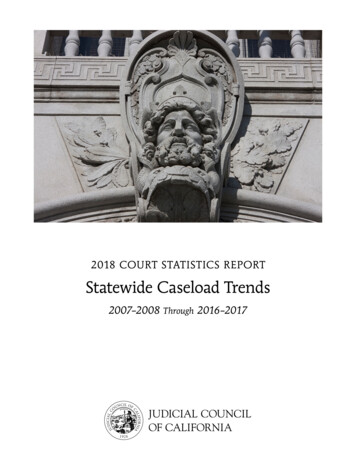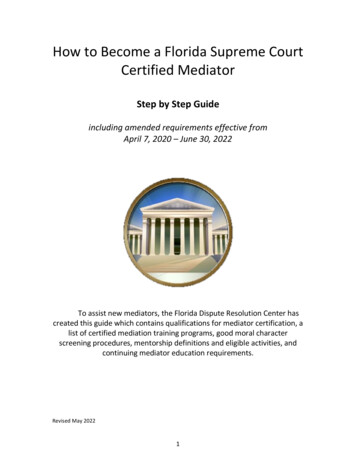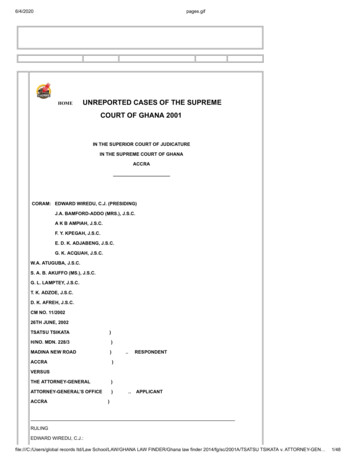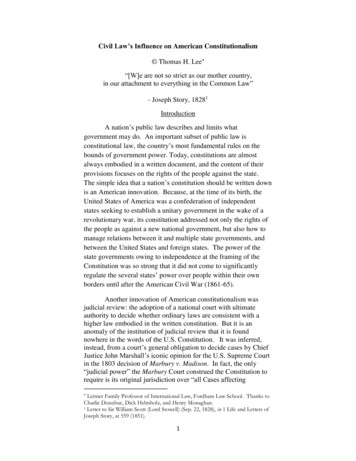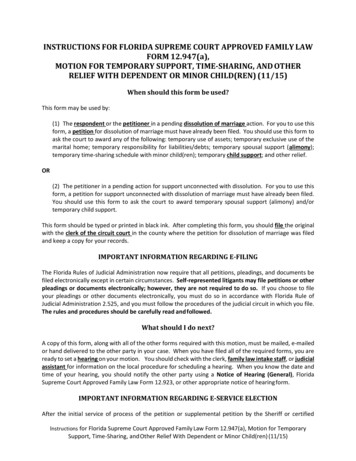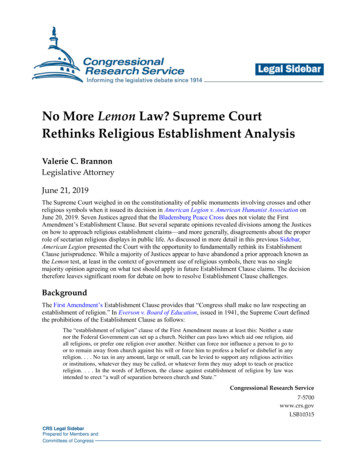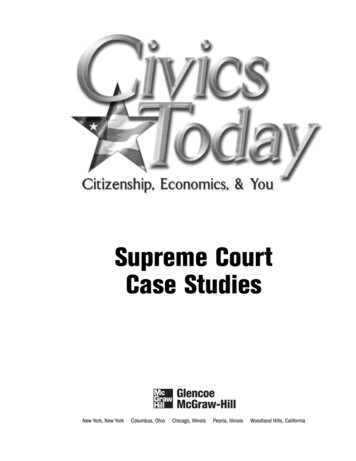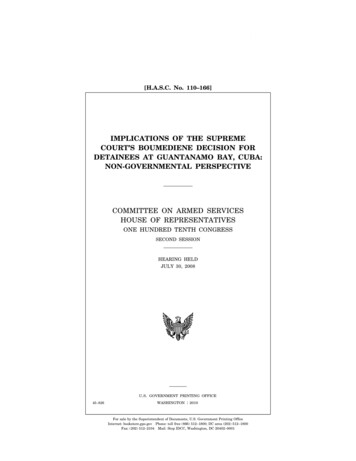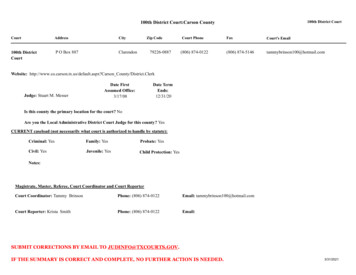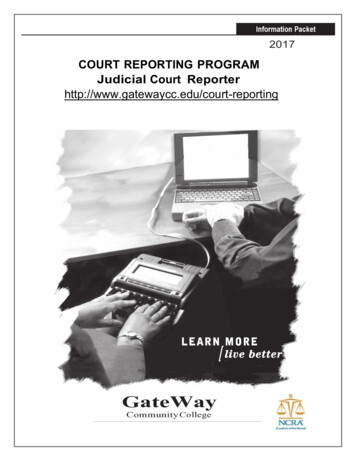
Transcription
Nos. 20-1199, 21-707IN THESupreme Court of the United StatesSTUDENTS FOR FAIR ADMISSIONS, INC.,Petitioner,v.PRESIDENT AND FELLOWS OF HARVARD COLLEGE,Respondent.STUDENTS FOR FAIR ADMISSIONS, INC.,Petitioner,v.UNIVERSITY OF NORTH CAROLINA, ET AL.,Respondents.On Writs of Certiorari to the United StatesCourts of Appeals for the First Circuit andFourth CircuitsBRIEF OF THE NATIONAL EDUCATIONASSOCIATION AND SERVICE EMPLOYEESINTERNATIONAL UNION AS AMICI CURIAEIN SUPPORT OF RESPONDENTSALICE O’BRIENCounsel of RecordNICOLE G. BERNERJASON WALTAJOHN M. D'ELIAREBECCA YATESService EmployeesBETHEL HABTEInternational UnionNational Education1800 MassachusettsAssociationAve., N.W.1201 Sixteenth Street, N.W.Washington, D.C. 20036 Washington, D.C. 20036(202) 730-7466(202) 822-7035aobrien@nea.orgMosaic - (301) 927-3800 - Cheverly, MD
iTABLE OF CONTENTSPageTable of authorities . iiInterest of Amici Curiae . 1Introduction and summary of argument . 3Argument . 4I. Race continues to influence our ability toobtain a just and prosperous society . 5A. The inequitable apportionment ofeducational opportunities by race . 6B. Recent events demonstrate that racismand discrimination are not artifacts ofAmerican history, but persist in everyaspect of our society, including ourschools. 16II. Racially diverse schools provideeducational and social benefits to all . 20Conclusion . 35
iiCasesTABLE OF AUTHORITIESPagesAmbach v. Norwick, 441 U.S. 68 (1979) . 4City of Richmond v. J.A. Croson Co., 488U.S. 469 (1989) . 34Fisher v. Univ. of Tex., 570 U.S. 297 (2013) . 4Fisher v. Univ. of Tex., 579 U.S. 365 (2016) . 4–5Grutter v. Bollinger, 539 U.S. 306 (2003) . 5,26–27Regents of Univ. of Cal. v. Bakke, 438 U.S.265 (1978) . 5Wisconsin v. Yoder, 406 U.S. 205 (1972) . 4Statutes and RegulationsFla. Admin. Code R. 6A-1.094124. 17Tex. Educ. Code § 28.0022 . 17Other authoritiesKiara Alfonseca, Anti-Critical Race TheoryBill Signed Into Law by MississippiGovernor, ABC News (Mar. 15, 2022) . 17Gordon W. Allport, THE NATURE OFPREJUDICE (1954) . 24–25Derrick P. Alridge, The Limits of MasterNarratives in History Textbooks: AnAnalysis of Representations of MartinLuther King, Jr., 108 TEACHERS COLL.REC. 662 (2006) . 18,19Am. Univ. Sch. of Edu., Identifying GiftedStudents: Addressing the Lack ofDiversity in Gifted Education (Feb. 11,2021) . 11
iiiOther authorities (cont’d)Kalyn Belsha et al., Not Getting Into It: HowCritical Race Theory Laws Are CuttingShort Classroom Conversations,CHALKBEAT (Dec. 17, 2021) . 17James Benson & Geoffrey Borman, Family,Neighborhood, and School SettingsAcross Seasons: When Do SocioeconomicContext and Racial Composition Matterfor the Reading Achievement Growth ofYoung Children?, 112 TEACHERS COLL.REC. 1338 (2010) . 22Mark Berends & Roberto V. Peñaloza,Increasing Racial Isolation and TestScore Gaps in Mathematics: A 30-YearPerspective, 112 TEACHERS COLL. REC.978 (2010) . 21Marianne Bertrand & Sendhil Mullainathan,Are Emily and Greg More Employablethan Lakisha and Jamal? A FieldExperiment on Labor MarketDiscrimination, 94 AM. ECON. REV. 991(2004) . 15Zachary Bleemer, Affirmative Action,Mismatch, and Economic Mobility AfterCalifornia’s Proposition 209, 137 Q. J.ECON. 115 (2022) . 32Geoffrey Borman & Maritza Dowling,Schools and Inequality: A MultilevelAnalysis of Coleman’s Equality ofEducational Opportunity Data, 112TEACHERS COLL. REC. 1201 (2010) . 22
ivOther authorities (cont’d)Nicholas A. Bowman, How Much Diversity IsEnough? The Curvilinear RelationshipBetween College Diversity Interactionsand First-Year Student Outcomes, 54RES. HIGHER EDUC. 874 (2013) . 29Jomills Henry Braddock II & Amaryllis DelCarmen Gonzalez, Social Isolation andSocial Cohesion: The Effects of K–12Neighborhood and School Segregation onIntergroup Orientations, 112 TEACHERSCOLL. REC. 1631 (2010) . 30Jomills Henry Braddock II & James M.McPartland, Social-PsychologicalProcesses that Perpetuate RacialSegregation, 19 J. BLACK STUDIES 267(1989) . 29–30Brookings Inst., The Polarization of JobOpportunities in the U.S. Labor Market(April 2010). 13Audra D.S. Burch & Luke Vander Ploeg,Buffalo Shooting Highlights Rise of HateCrimes Against Black Americans, N.Y.TIMES (May 16, 2022) . 16Bureau of Labor Statistics, Education Pays2020 (June 2021) . 13Bureau of Labor Statistics, Labor ForceCharacteristics by Race and Ethnicity,2019 (Dec. 2020) . 13Elise Cappella et al., The Hidden Role ofTeachers: Child and ClassroomPredictors of Change in InterracialFriendships, 37 J. EARLY ADOLESCENCE1093 (2017) . 27
vOther authorities (cont’d)Desiree Carver-Thomas & Linda DarlingHammond, The Trouble with TeacherTurnover: How Teacher Attrition AffectsStudents and Schools, 27 EDUC. POL’YANALYSIS ARCHIVES 1 (2019) . 8–9Century Found., The Benefits ofSocioeconomically and RaciallyIntegrated Schools and Classrooms (Apr.29, 2019) . 22Mark J. Chin, Bias in the Air: A NationwideExploration of Teachers’ Implicit RacialAttitudes, Aggregate Bias, and StudentOutcomes, 49 EDUC. RESEARCHER 566(2020) . 14Civil Rights Project, E Pluribus . . .Separation: Deepening DoubleSegregation for More Students (2012) . 7David S. Crystal et al., It Is Who You KnowThat Counts: Intergroup Contact andJudgments About Race-Based Exclusion,26 BRIT. J. DEV. PSYCH. 51 (2008) . 25Stacy B. Dale & Alan B. Krueger, Estimatingthe Effects of College Characteristics overthe Career Using AdministrativeEarnings Data, 49 J. HUMAN RES. 323(2014) . 23Linda Darling-Hammond, Teacher Qualityand Student Achievement: A Review ofState Policy Evidence, 8 EDUC. POL’YANALYSIS ARCHIVES 1 (2000) . 8Econ. Pol’y Inst., Schools Are StillSegregated, and Black Children ArePaying a Price (Feb. 12, 2020) . 8
viOther authorities (cont’d)Debbie Elliott, 5 Years After CharlestonChurch Massacre, What Have WeLearned?, NPR (Jun. 17, 2020) . 16Cynthia Estlund, Working Together: TheWorkplace, Civil Society, and the Law, 89GEO. L. J. 1 (2000) . 25Michael Ewens et al., StatisticalDiscrimination or Prejudice? A LargeSample Field Experiment, 96 REV. ECON.& STAT. 119 (2014) . 14Erin M. Fahle et al., Racial Segregationand School Poverty in the United States,1999–2016, 12 RACE & SOC. PROB. 42(2020) . 7Fed. Reserve Bank of N.Y., The LaborMarket for Recent College Graduates(May 11, 2022) . 13Mary J. Fischer & Douglas S. Massey, TheEffects of Affirmative Action in HigherEducation, 36 SOC. SCI. RESEARCH 531(2007) . 23Adrian Florido, Teachers Say Laws BanningCritical Race Theory Are Putting a Chillon Their Lessons, NPR (May 28, 2021) . 18Samuel L. Gaertner et al., How doesCooperation Reduce Intergroup Bias?, 59J. PERSONALITY & SOC. PSYCHOL. 692(1990) . 28Liliana M. Garces, Racial Diversity,Legitimacy, and the Citizenry: TheImpact of Affirmative Action Bans onGraduate School Enrollment, 36 REV.HIGHER EDUC. 93 (2012) . 32
viiOther authorities (cont’d)Liliana M. Garces & Courtney D. Cogburn,Beyond Declines in Student BodyDiversity: How Campus-LevelAdministrators Understand a Prohibitionon Race-Conscious PostsecondaryAdmissions Policies, 52 AM. EDUC. RES. J.828 (2015) . 33Liliana M. Garces & David Mickey-Pabello,Racial Diversity in the MedicalProfession: The Impact of AffirmativeAction Bans on UnderrepresentedStudent of Color Matriculation inMedical Schools, 86 J. HIGHER EDUC. 264(2015) . 32Pat Rubio Goldsmith, Learning Apart, LivingApart: How the Racial and EthnicSegregation of Schools and CollegesPerpetuates Residential Segregation, 112TEACHERS COLL. REC. 1602 (2010) . 30–31Dana Goldstein, Two States. EightTextbooks. Two American Stories, N.Y.Times (Jan. 12, 2020) . 20Bernadette Gray-Little & Robert A. Carels,The Effect of Racial Dissonance onAcademic Self-Esteem and Achievementin Elementary, Junior High, and HighSchool Students, 7 J. RES. ONADOLESCENCE 109 (1997) . 21Anne Gregory et al., The Achievement Gapand the Discipline Gap: Two Sides of theSame Coin?, 39 EDUC. RES. 59 (2010) . 11Patricia Gurin et al., The Benefits ofDiversity in Education for DemocraticCitizenship, 60 J. SOC. ISSUES 17 (2004) . 29
viiiOther authorities (cont’d)Nicole Hannah-Jones, THE 1619 PROJECT: ANEW ORIGIN STORY (2021) . 17Shaun R. Harper & Andrew H. Nichols, AreThey Not All the Same? RacialHeterogeneity Among Black MaleUndergraduates, 49 J. COLL. STUDENTDEV. 204 (May/June 2008) . 26C. Kirabo Jackson, Student Demographics,Teacher Sorting and Teacher Quality:Evidence from the End of SchoolDesegregation, 27 J. LAB. ECON. 213(2009) . 8Omari Jackson & David M. Merolla,Structural Racism as the FundamentalCause of the Academic Achievement Gap,13 SOCIOLOGY COMPASS 8 (2019) . 11Drew S. Jacoby-Senghor et al., A Lesson inBias: The Relationship Between ImplicitRacial Bias and Performance inPedagogical Contexts, 63 J. EXPER. SOC.PSYCH. 50 (2016) . 15Jaana Juvonen et al., When and How DoStudents Benefit From Ethnic Diversityin Middle School?, 89 CHILD DEV. 1268(2018) . 29William C. Kidder, Misshaping the River:Proposition 209 and Lessons for theFisher Case, 39 J.C. & U.L. 53 (2013) . 33William C. Kidder & Patricia Gándara, TwoDecades After the Affirmative Action Ban:Evaluating the University of California’sRace-Neutral Efforts, ETS WHITE PAPER(2016) . 34
ixOther authorities (cont’d)David S. Knight, Are School DistrictsAllocating Resources Equitably? TheEvery Student Succeeds Act, TeacherExperience Gaps, and Equitable ResourceAllocation, 33 EDUC. POL’Y 615 (2019) . 9Michal Kurlaender & John T. Yun, IsDiversity a Compelling EducationalInterest?, in DIVERSITY CHALLENGED:EVIDENCE ON THE IMPACT OF AFFIRMATIVEACTION (Gary Orfield ed., 2001) . 28,30Justin D. Levinson et al., Guilty by ImplicitRacial Bias: The Guilty/Not GuiltyImplicit Association Test, 8 OHIO ST. J.CRIM. L. 187 (2010) . 14Chad Loes et al., Effects of DiversityExperiences on Critical Thinking Skills:Who Benefits?, 83 J. HIGHER EDUC. 1(2012) . 29Mark C. Long, Affirmative Action and ItsAlternatives in Public Universities: WhatDo We Know?, 67 PUB. ADMIN. REV. 315(2007) . 34Kent McIntosh et al., Education NotIncarceration: A Conceptual Model forReducing Racial and EthnicDisproportionality in School Discipline, 5J. APPLIED RES. CHILD. 1 (2014) . 10Roslyn Arlin Mickelson & Martha Bottia,Integrated Education and MathematicsOutcomes: A Synthesis of Social ScienceResearch, 88 N.C. L. REV. 993 (2010) . 20–21
xOther authorities (cont’d)Jeffrey F. Milem, The Educational Benefits ofDiversity: Evidence from MultipleSectors, in COMPELLING INTEREST(Mitchell J. Chang et al. eds., 2003) . 27Toni Morrison, THE BLUEST EYE (1970) . 18Nat’l Ass’n for Gifted Children, Gifted andTalented: Finding and CalculatingRepresentation Rates, (Feb. 25, 2019) . 11Nat’l Bureau of Econ. Res., Long-RunImpacts of School Desegregation &School Quality on Adult Attainments,(Sept. 2015). 24Nat’l Educ. Ass’n, Teach Truth: Know YourRights FAQ (Jun. 2, 2022) . 17Elavie Ndura, ESL and Cultural Bias: AnAnalysis of Elementary Through HighSchool Textbooks in the Western UnitedStates of America, 17 J. LANGUAGECULTURE & CURRICULUM 143 (2004) . 18,19Xiaoxia A. Newton, End-of-High-SchoolMathematics Attainment: How DidStudents Get There?, 112 TEACHERSCOLL. REC. 1064 (2010) . 21Tuan D. Nguyen & Christopher Redding,Changes in the Demographics,Qualifications, and Turnover ofAmerican STEM Teachers, 1988–2012, 4AERA OPEN 1 (2018) . 8Brian A. Nosek et al., Harvesting ImplicitGroup Attitudes and Beliefs from aDemonstration Web Site, 6 GROUPDYNAMICS: THEORY, RESEARCH & PRAC.101 (2002) . 14
xiOther authorities (cont’d)Ann Owens & Jennifer Candipan, Social andSpatial Inequalities of EducationalOpportunity: A Portrait of SchoolsServing High- and Low-IncomeNeighbourhoods in US MetropolitanAreas, 56 URBAN STUDIES 3178 (2019) . 11–12Thomas Peele & Daniel J. Willis, DroppingAffirmative Action Had Huge Impact onCalifornia’s Public Universities,EDSOURCE (Oct. 29, 2020) . 31Pell Inst., Indicators of Higher EducationEquity in the United States: 2021Historical Trend Report (2021) . 15Thomas F. Pettigrew, Future Directions forIntergroup Contact Theory and Research,32 INT’L J. INTERCULTURAL REL. 187(2008) . 26Katherine W. Phillips, How Diversity Works,311 SCI. AM. 42 (Oct. 2014) . 28Kristie J.R. Phillips al., Integrated Schools,Integrated Futures? A Case Study ofSchool Desegregation in JeffersonCounty, Kentucky, in FROM THECOURTROOM TO THE CLASSROOM: THESHIFTING LANDSCAPE OF SCHOOLDESEGREGATION (Claire E. Smrekar &Ellen B. Goldring, eds., 2009). 30Sean F. Reardon et al., Is Separate StillUnequal? New Evidence on SchoolSegregation and Racial AcademicAchievement Gaps, CEPA WORKINGPAPER NO. 19.06 (2021) . 12
xiiOther authorities (cont’d)Jason Reynolds & Ibram X. Kendi, STAMPED(FOR KIDS): RACISM, ANTIRACISM, ANDYOU (2021) . 17–18Argun Saatcioglu, Disentangling School- andStudent-Level Effects of Desegregationand Resegregation on the DropoutProblem in Urban High Schools:Evidence From the Cleveland MunicipalSchool District, 1977–1998, 112TEACHERS COLL. REC. 1391 (2010) . 23Sarah Schwartz, Map: Where Critical RaceTheory is Under Attack, EDUC. WEEK(June 28, 2022) . 18Lee Sigelman et al., Making Contact? BlackWhite Social Interaction in an UrbanSetting, 101 AM. J. SOC. 1306 (Mar. 1996) . 30Allison L. Skinner & Andrew N. Meltzoff,Childhood Experiences and IntergroupBiases among Children, 13 SOC. ISSUES &POL’Y REV. 211 (2019) . 27Robert E. Slavin, Cooperative Learning:Applying Contact Theory in DesegregatedSchools, 41 J. SOC. ISSUES 45 (1985) . 27Mario L. Small & Christopher Winship,Black Students’ Graduation From EliteColleges: Institutional Characteristicsand Between-Institution Differences, 36SOC. SCI. RESEARCH 1257 (2007) . 23Elizabeth Stearns, Long-Term Correlates ofHigh School Racial Composition:Perpetuation Theory Reexamined, 112TEACHERS COLL. REC. 1654 (2010) . 31Angie Thomas, THE HATE U GIVE (2017) . 18
xiiiOther authorities (cont’d)U.S. Census Bureau, Demographic TurningPoints for the United States: PopulationProjections for 2020 to 2060 (Feb. 2020) . 6U.S. Census Bureau, School Enrollment inthe United States: 2011 (Sept. 2013) . 12U.S. Dep’t of Educ., Data Snapshot: Collegeand Career Readiness (March 2014) . 10U.S. Dep’t of Educ., Data Snapshot: TeacherEquity (March 2014) . 8U.S. Dep’t of Educ., Dear Colleague Letter(Oct. 1, 2014) . 9–10U.S. Dep’t of Educ., Key Data Highlights onEquity and Opportunity Gaps in OurNation’s Public Schools (Oct. 28, 2016) . 10U.S. Dep’t of Educ., Racial/EthnicEnrollment in Public Schools (2022) . 6–7U.S. Dep’t of Educ., Report on the Conditionof Education 2021 (May 2021). 12U.S. Dep’t of Educ. & U.S. Dep’t of Treas.,The Economic Case for Higher Education(June 21, 2012) . 13U.S. Dep’t of Justice, 2020 Hate CrimesStatistics (May 5, 2022) . 16U.S. Gov’t Accountability Office, K-12Education: Student Population HasSignificantly Diversified, But ManySchools Remain Divided Along Racial,Ethnic, and Economic Lines (June 2022) . 7–8
xivOther authorities (cont’d)Loris Vezzali, Increasing Outgroup Trust,Reducing Infrahumanization, andEnhancing Future Contact Intentions ViaImagined Intergroup Contact, 48 J.EXPER. SOC. PSYCH. 437 (2012) . 26Adam Voight, et al., The Racial SchoolClimate Gap: Within-School Disparitiesin Students’ Experiences of Safety,Support, and Connectedness, 56 AM. J.CMTY. PSYCHOL. 252 (2015) . 28Peter B. Wood & Nancy Sonleitner, TheEffect of Childhood Interracial Contacton Adult Antiblack Prejudice, 20 INT’L J.INTERCULTURAL REL. 1 (1990) . 30Mihi Zaeri et al., “All These Innocent Lives”:These Were the Victims in the BuffaloAttack, N.Y. TIMES (May 15, 2022) . 16
1INTEREST OF AMICUS CURIAEThis Amici Curiae brief is submitted, with theconsent of the parties, on behalf of the National Education Association (“NEA”) and Service EmployeesInternational Union (“SEIU).1NEA is a nationwide employee organization ofnearly three million members, the vast majority ofwhom serve as educators and education support professionals in our nation’s public schools, colleges, anduniversities. NEA believes that “a diverse society enriches all individuals” and that “[e]ducation shouldfoster a vibrant, pluralistic society that authenticallyreflects diverse populations and cultural perspectives.” NEA Resolution B-12 (2015). Similarly, NEArecognizes that “a racially diverse student populationis essential for all elementary/secondary schools, colleges, and universities to promote racial equality, improve academic performance, and foster a robust exchange of ideas.” NEA Resolution B-13 (2015).Such diversity cannot “be achieved or maintainedin all cases simply by ending discriminatory practicesand treating all students equally regardless of race.”Id. Rather, in order to “enhance equity in the education of our students,” NEA recognizes that “it may benecessary for elementary/secondary schools, colleges,and universities to take race into account in makingdecisions as to student admissions, assignments,and/or transfers.” Id. That is so because “both histori1 This brief is filed with the written consent of both parties.Amici state that no party’s counsel authored the brief in wholeor in part; no party’s counsel contributed money that was intended to fund preparing or submitting the brief; and no person—other than Amici—contributed money that was intended tofund preparing or submitting the brief.
2cal and current practices have systematically advantaged and privileged people of White European ancestry while disadvantaging and denying rights, opportunities, and equality for people of color.” NEA Resolution I-53 (2017). Only by actively pursuing “socialand educational strategies fostering the eradicationof institutional racism” can our society achieve“[r]acial justice in education” and “equitable opportunities and outcomes for people of all races.” NEA Resolution I-52 (2018).SEIU is a labor union representing approximately two million working people in the United States,Puerto Rico, and Canada. Our members work in essential jobs across healthcare, building and propertyservices, and public service. Thousands of our members are educators and thousands more are essentialsupport workers that keep schools and colleges running. SEIU believes that workers’ struggle for economic justice is intertwined with, and inseparablefrom, our struggle for racial justice. Neither can bewon without the other. In June 2020, our International Executive Board adopted a resolution affirmingSEIU’s support for the Movement for Black Lives. Atour 2016 Convention, SEIU adopted Resolution 106A,in which we committed to becoming an anti-racist organization. The Resolution acknowledges that “racehas historically been one of the most powerful waysto pit working people against one another” and that“[r]acism is a key way that the wealthy few regularlystructure and hijack our economy and government tobenefit themselves and disadvantage the vast majority of people, including white people.” The Resolutionspecifically identifies racial “education . . . disparities” as a problem. SEIU believes that race-consciousschool admissions policies are an important tool for
3reducing such disparities and achieving an inclusiveand equitable society in which all of us may flourish.INTRODUCTION ANDSUMMARY OF ARGUMENTSince 2016—when the issue of race-consciousuniversity admissions was last before the Court—ournational conversation on race has shifted significantly. In 2017, torch-wielding white supremacists descended on Charlottesville, Virginia for a “Unite theRight” rally resulting in the murder of a peaceful protester and marking another rising tide of organizedwhite supremacist violence in our country. In thesummer of 2020, the murder of George Floyd by police officers sparked some of the largest racial justiceprotests in our nation’s history and spurred a vibrantdebate about racial justice and police practices. Andthe continuing COVID pandemic has exacerbated andlaid bare continuing deep racial inequities in accessto healthcare and education and the life and deathconsequences of those disparities.Today, the reality remains that race still carriesgreat weight in our society and continues to carve outlanes of opportunity and of peril based solely on thecolor of one’s skin. That remains true across our society, including in our nation’s schools, where race continues to carry great weight—dividing educationalopportunities inequitably and distorting perceptionswith stereotypes and prejudice.One of the most effective tools for curbing thesecontinuing inequities is to ensure racially integratedelementary and secondary schools and institutions ofhigher education. Such schools and classrooms notonly help to overcome our nation’s deplorable legacyof slavery, segregation, and discrimination, but also—and more to the point in the present context—enable
4schools to fulfill their dual mission of instilling in allstudents “the values on which our society rests,” Ambach v. Norwick, 441 U.S. 68, 76 (1979), and providing them with the skills and knowledge necessary torealize their full potential, see Wisconsin v. Yoder,406 U.S. 205, 239 (1972). Education remains key toachieving economic mobility and increasing the prospects for success in society, and integrated schoolsand classrooms are the most successful way to ensureequal opportunity for all students. To accomplishthose ends, educational institutions should be permitted to consider race and ethnicity when making educational policy judgments (ranging from school attendance zones to college admissions criteria) thataffect the composition of schools and classrooms.The societal and educational benefits of raciallydiverse classrooms in elementary, secondary, andhigher education are well documented. A robust bodyof empirical research confirms that racially diverseschools and classrooms produce tangible and lastingimprovements in academic achievement for all students of both majority and minority races. Classroomcontact among students of different races reduces stereotypes and prejudice and has been found to be moreeffective in promoting tolerance and cross-racial understanding than any other pedagogical method.Classrooms with a “critical mass” of minority students help to equalize opportunity, break down stereotypes, and offer enduring benefits to a multiracial,democratic society, and its citizens.ARGUMENTIn 2013 and again in 2016, this Court reaffirmedthat attaining a diverse student body with its concomitant educational benefits is a compelling stateinterest. Fisher v. Univ. of Tex., 570 U.S. 297, 310–11(2013); Fisher v. Univ. of Tex., 579 U.S. 365, 381
5(2016). Recent events demonstrate that this interestis stronger than ever and that the beneficial effects ofdiversity in schools is even more needed in order topromote “‘cross-racial understanding,’ help[] to breakdown racial stereotypes,” precipitate “more enlightening” classroom discussion, promote better “learningoutcomes” and “better prepare[] students for an increasingly diverse workforce and society.” Grutter v.Bollinger, 539 U.S. 306, 330 (2003). Those interestsremain compelling; nothing less than the “nation’sfuture depends upon leaders trained through wideexposure to the ideas and mores of students as diverse as this Nation of many peoples.” Regents ofUniv. of Cal. v. Bakke, 438 U.S. 265, 313 (1978) (Powell, J.) (cleaned up).I.Race Continues to Influence Our Ability toObtain a Just and Prosperous SocietyIn 2003, this Court predicted optimistically thatwithin 25 years, schools would be able to achieve racial diversity without using any racial preferences inadmissions. Grutter, 539 U.S. at 343. Justice Ginsburg similarly hoped that “progress toward nondiscrimination and genuinely equal opportunity [would]make it safe to sunset affirmative action.” Id. at 346(concurring opinion). But she recognized “the currentreality that many minority students encounter markedly inadequate and unequal educational opportunities.” Id. Unfortunately, that progress has not materialized. Our schools, from K-12 to higher education,still struggle to provide equitable opportunities forstudents of color. And racial injustice continues toplague our society.
6A. The inequitable apportionment of educational opportunities by raceRace continues to carry great weight, dividingeducational opportunities inequitably, denying largeswaths of our populace the opportunity to succeed,and distorting perceptions with stereotypes and prejudice.1. Even now, a student’s race is still, by itself,largely predictive of the racial composition of the elementary and secondary schools they will attend. TheU.S. Census Bureau projects that, by 2045, Whiteswill no longer represent a majority of the U.S. populations.2 By 2060, only 44.3% of the population is projected to be White—and the racial and ethnic composition of children is expected to change more quicklythan for adults, with over one-third of children expected to be White in 2060 compared with over onehalf of adults.3Yet, despite this increasing diversity, our publicelementary and secondary schools remain heavilysegregated. In the 2019-2020 school year, the averageWhite student attended a majority White school.4 Bycontrast, students of color are far more likely to attend schools where the majority of students are alsostudents of color.5 Overall, while more than half of allBlack (59%) and Hispanic (60%) public elementaryand secondary students attended public schools in2 U.S. Census Bureau, Demographic Turning Points for theUnited States: Population Projections for 2020 to 2060 at 7 (Feb.2020).3 Id. at 4.4 U.S. Dep’t of Educ., Racial/Ethnic Enrollment in PublicSchools (2022).5 Id.
7which minority enrollment was at least 75%, only 6%of White students attended such schools.6 Conversely,only 4% of Black students and 5% of Hispanic students attended public schools in which the enrollmentwas at least 75% White, while 46% of White studentsattended such schools.7This extreme segregation of Black and Hispanicis increasing. From the 1990-1991 school year to the2019-2020 school year, the enrollment for Black students in schools with a student body comprised of atleast 75% Black and other racial minority studentsincreased by nearly 15 percentage points (from 44.8%to 59%); over the same time pe
versity in the Medical Profession: The Impact of Affirmative Ac-tion Bans on Underrepresented Student of Color Matriculation in Medical Schools, 86 J. H IGHER E DUC. 264 (2015). 108 Liliana M. Garces, Racial Diversity, Legitimacy, and the Citizenry: The Impact of Affirmative Action Bans on Graduate School Enrollment, 36 R EV. H IGHER E DUC. 93 .
